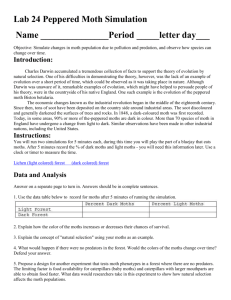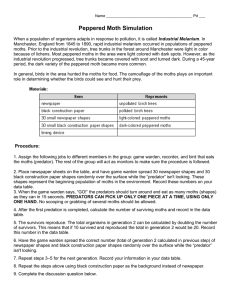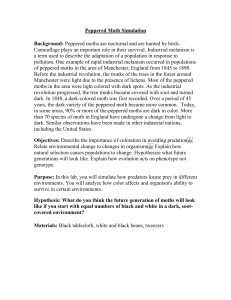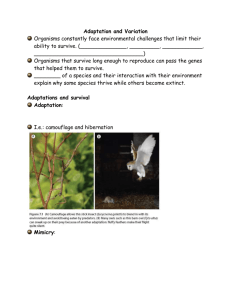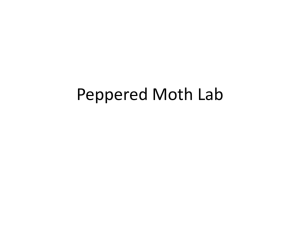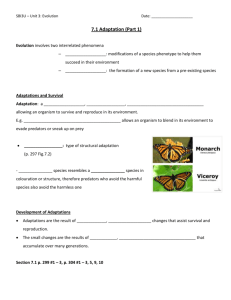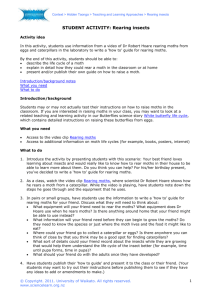Peppered Moth Simulation
advertisement
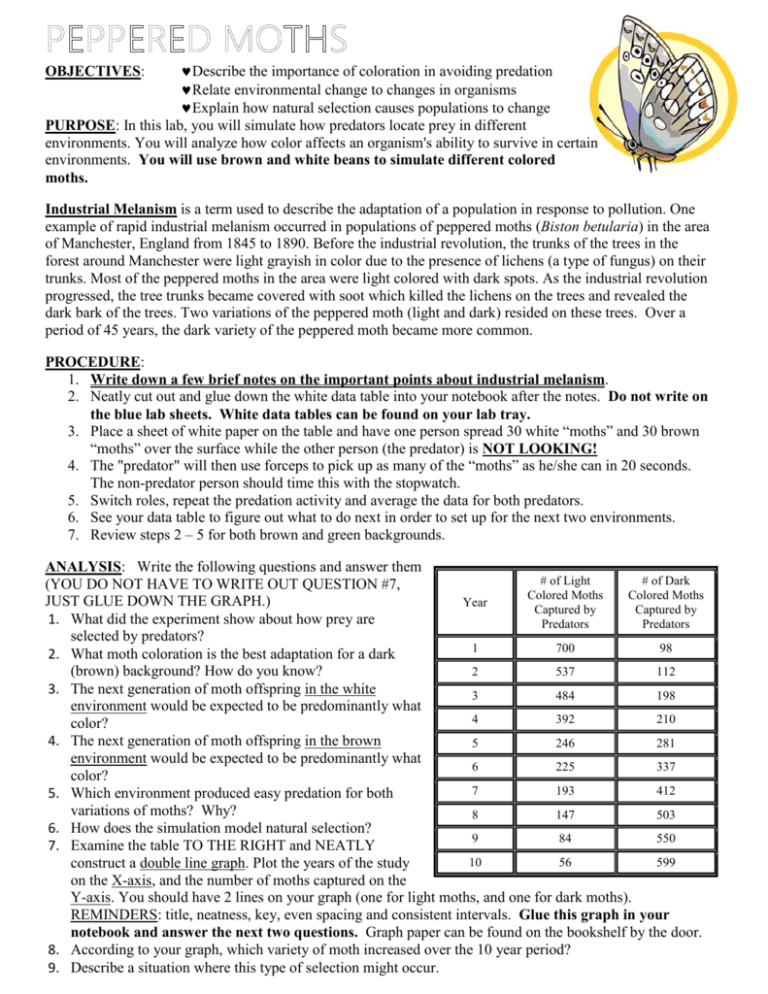
Describe the importance of coloration in avoiding predation Relate environmental change to changes in organisms Explain how natural selection causes populations to change PURPOSE: In this lab, you will simulate how predators locate prey in different environments. You will analyze how color affects an organism's ability to survive in certain environments. You will use brown and white beans to simulate different colored moths. OBJECTIVES: Industrial Melanism is a term used to describe the adaptation of a population in response to pollution. One example of rapid industrial melanism occurred in populations of peppered moths (Biston betularia) in the area of Manchester, England from 1845 to 1890. Before the industrial revolution, the trunks of the trees in the forest around Manchester were light grayish in color due to the presence of lichens (a type of fungus) on their trunks. Most of the peppered moths in the area were light colored with dark spots. As the industrial revolution progressed, the tree trunks became covered with soot which killed the lichens on the trees and revealed the dark bark of the trees. Two variations of the peppered moth (light and dark) resided on these trees. Over a period of 45 years, the dark variety of the peppered moth became more common. PROCEDURE: 1. Write down a few brief notes on the important points about industrial melanism. 2. Neatly cut out and glue down the white data table into your notebook after the notes. Do not write on the blue lab sheets. White data tables can be found on your lab tray. 3. Place a sheet of white paper on the table and have one person spread 30 white “moths” and 30 brown “moths” over the surface while the other person (the predator) is NOT LOOKING! 4. The "predator" will then use forceps to pick up as many of the “moths” as he/she can in 20 seconds. The non-predator person should time this with the stopwatch. 5. Switch roles, repeat the predation activity and average the data for both predators. 6. See your data table to figure out what to do next in order to set up for the next two environments. 7. Review steps 2 – 5 for both brown and green backgrounds. ANALYSIS: Write the following questions and answer them # of Light # of Dark (YOU DO NOT HAVE TO WRITE OUT QUESTION #7, Colored Moths Colored Moths JUST GLUE DOWN THE GRAPH.) Year Captured by Captured by 1. What did the experiment show about how prey are Predators Predators selected by predators? 1 700 98 2. What moth coloration is the best adaptation for a dark 2 537 112 (brown) background? How do you know? 3. The next generation of moth offspring in the white 3 484 198 environment would be expected to be predominantly what 4 392 210 color? 4. The next generation of moth offspring in the brown 5 246 281 environment would be expected to be predominantly what 6 225 337 color? 7 193 412 5. Which environment produced easy predation for both variations of moths? Why? 8 147 503 6. How does the simulation model natural selection? 9 84 550 7. Examine the table TO THE RIGHT and NEATLY 10 56 599 construct a double line graph. Plot the years of the study on the X-axis, and the number of moths captured on the Y-axis. You should have 2 lines on your graph (one for light moths, and one for dark moths). REMINDERS: title, neatness, key, even spacing and consistent intervals. Glue this graph in your notebook and answer the next two questions. Graph paper can be found on the bookshelf by the door. 8. According to your graph, which variety of moth increased over the 10 year period? 9. Describe a situation where this type of selection might occur. STARTING MOTH POPULATION Predator BACKGROUND Brown Spotted White 1 white 30 30 2 white 30 30 NUMBER OF MOTHS CAPTURED White Brown Average for white background 1 brown 30 30 2 brown 30 30 Average for brown background 1 green 30 30 2 green 30 30 Average for green background STARTING MOTH POPULATION Predator BACKGROUND Brown Spotted White 1 white 30 30 2 white 30 30 Average for white background 1 brown 30 30 2 brown 30 30 Average for brown background 1 green 30 30 2 green 30 30 Average for green background NUMBER OF MOTHS CAPTURED White Brown


